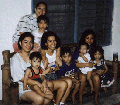We took a jeepney to Marikina, a suburb of Manila, to visit Lani's brother and sisters. We started out at 4:45 pm from our hotel in Manila in the middle of rush hour traffic. The ride was agonizingly slow and the carbon monoxide and smog levels were nearly intolerable. The ride was so slow and we were so lacking in entertainment that we started watching a jogger running in the same general direction as our jeepney was traveling. He was keeping a very mild marathon pace but was passing our jeepney. He would get ahead several blocks, then traffic would let up briefly and we would get ahead. Traffic would jam up again and he would pass us. This cycle repeated itself several times before he vanished into the distance in front of us.
We stopped at a Jolly Bees restaurant for a quick thirty minute meal and then caught another jeepney going in the right direction. We had change jeepneys near the end of the trip to go in a different direction and Kurt and I got to hang on the back of the jeepney because it was full. It was rather fun and I am glad we got the chance to experience it. At least we got to see where we were going for a change. All in all the ride took 2.5 hours and cost P12. Surprisingly enough the distance traveled in that length of time was not very significant. The traffic was the problem! We took a taxi back to the hotel at midnight and the entire trip took only 20 minutes and cost P95.
 Lani's
family was a typical lower middle class family - everybody graduated
from college. The household contained under one roof, four complete
families of her brothers and sisters and four house keepers/nannies.
Two of the men worked in sales positions, the third was a computer
programmer and the fourth was an architect. Several times one
of the families has considered a separate house but it has just
not been financially feasible. Instead, over the last six years
they have put a great deal of effort into remodeling the existing
house to make it larger.
Lani's
family was a typical lower middle class family - everybody graduated
from college. The household contained under one roof, four complete
families of her brothers and sisters and four house keepers/nannies.
Two of the men worked in sales positions, the third was a computer
programmer and the fourth was an architect. Several times one
of the families has considered a separate house but it has just
not been financially feasible. Instead, over the last six years
they have put a great deal of effort into remodeling the existing
house to make it larger.
The house seems to be in constant turmoil as family members came and went and children ran all over the place. When we arrived at 7:30 pm children were being fed and the meal we were to eat was being prepared. Separate families took turns in the kitchen feeding their families because the kitchen table and other facilities were not capable of handling more than six to eight people at a time. Food preparation was done in the kitchen but most of the cooking was done outside. The back yard was small and had a tin awning which covered all but a few feet of it. There were two-burner propane powered cook plates out there, as well as a charcoal fueled barbecue grill. I assumed this was done to keep heat and smoke out of the house and save on interior space.
To contribute to the meal we brought a papaya and pineapple we had purchased at the local market. It is traditional to bring some sort of food offering when visiting. A cake or pastry would have been a more traditional choice, but the fruit seemed to go over very well and Kurt and I wanted to try them. I was assigned to prepare the pineapple.
The Philippine method of cutting a pineapple differs greatly from methods I have seen employed in the United States. After carving one the Filipino way, I can see why it never caught on in the United States; it is rather labor intensive. First, you make shallow vertical cuts removing the bulk of the scaly outside layer being careful not to cut deep enough to remove the small round indentations of skin called the eyes. Now comes the time intensive part. Starting at the top, make small V shaped cuts just deep and wide enough to remove the eyes. They have to be small cuts which remove one strand of diagonal eyes. Since I've never cut up a pineapple before, Lani's brother told me to cut two eyes off at a time. If that weren't enough, the cuts must also form a decorative spiral pattern going down the pineapple. Once the entire pineapple is devoid of eyes, the top and bottom ends are removed. From there it can be quartered or sliced into rings.
Other menu items for the night included slow-roasted chicken, blood beef, and pancit (rice noodles). The family members have done very little pleasure travel in their own country, so they were very interested in the stories about the places we had been, the things we had seen and most importantly, how much everything had cost. Lani got out her Sharp viewcam and played some of the video tapes we had made.
We adjourned to the front porch about 10:00pm. The front porch is very large with comfortable furnishings. It appeared to be a more frequented area of the house than the living room. We talked here for half an hour and then started making plans to leave. It was then that Kurt opened his big mouth and got me in all kinds of trouble. He pointed out to the family that today was my birthday. The family immediately started a whole bunch of fussing about what they called an old Filipino tradition of eating a 'Balut' on your birthday. I didn't buy the tradition because it was clear they were using this as an excuse to introduce me to something they didn't think I would have done otherwise.

![]()
 They were right! Balut
is a fertilized duck egg which has undergone a fair amount of
embryonic development (2-3 weeks) and then been boiled. Lani's
brother, JoJo, ran off the porch into the darkness and came back
a few seconds later with a hot Balut. The family fussed at him
for returning with only one egg, so off he went again returning
with several more eggs in just a few seconds. Upon his return
the second time we had to ask where the eggs were coming from.
I don't know what the odds are of this happening, but apparently
they are pretty good in the Philippines... here is how the story
goes. A Balut vendor on a three-wheeled bicycle just happened
to be riding by the house at the exact same moment we were talking
about eating Balut. He overheard our conversation and stopped.
Balut vendors come out only at night and travel up and down residential
streets like this one several times a night. As for why Balut
can only be purchased at night, well, my guess is that the less
you see of a Balut, the more likely you will be to eat it.
They were right! Balut
is a fertilized duck egg which has undergone a fair amount of
embryonic development (2-3 weeks) and then been boiled. Lani's
brother, JoJo, ran off the porch into the darkness and came back
a few seconds later with a hot Balut. The family fussed at him
for returning with only one egg, so off he went again returning
with several more eggs in just a few seconds. Upon his return
the second time we had to ask where the eggs were coming from.
I don't know what the odds are of this happening, but apparently
they are pretty good in the Philippines... here is how the story
goes. A Balut vendor on a three-wheeled bicycle just happened
to be riding by the house at the exact same moment we were talking
about eating Balut. He overheard our conversation and stopped.
Balut vendors come out only at night and travel up and down residential
streets like this one several times a night. As for why Balut
can only be purchased at night, well, my guess is that the less
you see of a Balut, the more likely you will be to eat it.
Proper consumption of a Balut is as follows: First, crack the egg at the rounded end. While holding it upright remove a small portion of the shell. Next, place your lips over the hole and drink the embryonic fluid. There wasn't much and it appeared to be a clear liquid. After that, three-quarters of the shell, to all of the shell can be removed. This process as well as the actual consumption should ideally be done without looking at the fetal duck. Now, all that is left is to put some vinegar and salt on the egg and eat it. One final caution, there is an oddly shaped white thing at the narrow end of the egg which is hard. Although edible, it is advisable to discard it. By the way, the vendor served us the eggs in an envelope he had fashioned out of a single yellow page out of the phone book. He even added some salt at the bottom of the envelope for us. Salt in the Philippines, as well as sugar, is in much larger granules than typically seen in the United States.
The actual consumption of the Balut wasn't as bad as I had envisioned it to be. In the first bite I crunched into some small bone or perhaps the bird's beak. This I picked out and discarded while attempting not to think about what I was doing. I did disobey instructions and looked at it. It was a brownish black color and the developed organs could be seen. It kind of reminded me of the frog dissections that are required of high school students. To avoid any further mishaps I removed the hard white thing and the remainder of the shell and gulped the balance of the bird down in a second gulp. After I had finished my Balut, the rest of the family ate one, including two of their small children who split one. Balut is by nature a bit messy and I was quick to wash my hands afterwards.
 Book Your Trip To The Philippines Right Now!
Book Your Trip To The Philippines Right Now!Manila Bacolod Baguio Cebu Davao Palawan Banaue More Airline Reservations Tours Destination Guide |



